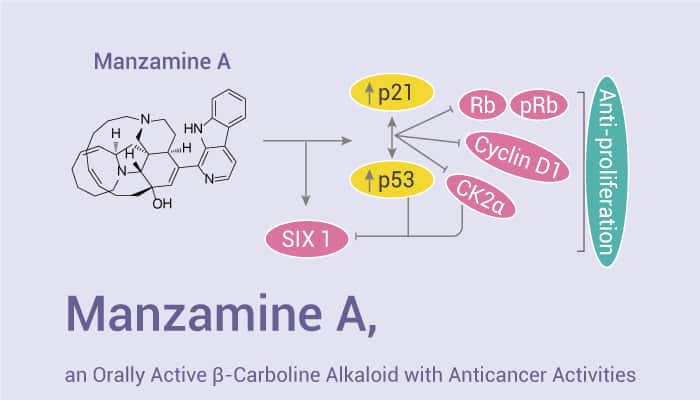AManzamine A is an orally active β-carboline alkaloid effective against HSV-1, Cancer, and Malaria.
For HSV-1, It is estimated that approximately 80% of the population worldwide are carriers of HSV-1 and approximately 40% suffer from recurrent infections. Unfortunately, this recurrent nature is a leading cause of corneal disease and blindness in humans. Manzamine A (1 µM, 24 h) effectively inhibits HSV-1 viral replication and infection in the cell line SIRC. Moreover, Manzamine A (1μM) reduces the release of HSV-1 by 1011-fold in CV-1 cells.
For cancer: Cervical squamous dysplasia and cancer are due to infectious agents such as human papillomavirus (HPV).

Research shows that Manzamine A decreases the levels of the oncoprotein SIX1. As a result, SIX1 is associated with oncogenesis in cervical cancer. Additionally, Manzamine A (0-40 μM; 48 h) inhibits the growth of C33A (HPV-negative) and HeLa (HPV16/18 positive) cells, with IC50s of 2.1 and 4.0 μM, respectively. Moreover, Manzamine A also inhibits pancreatic cancer cells by targeting vacuolar ATPases and inhibiting autophagy.
For malaria, Plasmodium berghei is a protozoan parasite that causes malaria in certain rodents. The multiplication of the parasite in the blood causes pathology such as anemia and damage of essential organs of the host such as the lungs, liver, and spleen. Manzamine A (50, 100 mol/kg; i.p./p.o.) inhibits the growth of the rodent malaria parasite Plasmodium berghei in infected mice. Moreover, Manzamine A (8 mg/kg, i.p., daily for 8 consecutive days) prolongs the survival of SW mice to 20 days.
All in all, Manzamine A is an orally active molecule that can be used for target cancer, virus, parasite, and bacteria infection research. And Manzamine A has good application value.
Reference: